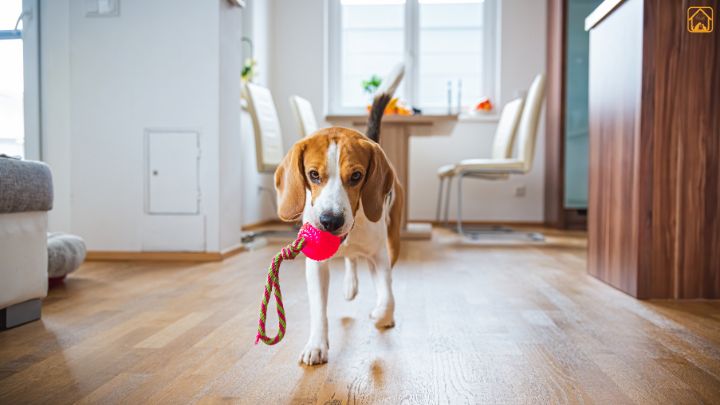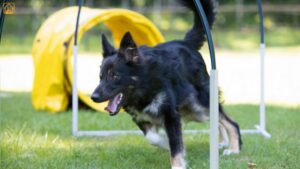Why Indoor Exercise is Crucial for Dogs
Dogs are built to move. Whether you have a couch-loving bulldog or a bouncy border collie, exercise isn’t just a “nice-to-have”, it’s a must for every dog’s body and mind. Without enough activity, dogs can get bored, anxious, or even develop health issues like obesity or joint stiffness.
It’s not only about burning calories. Regular indoor dog exercises help with:
- Weight management, keeping your dog at a healthy size
- Joint and muscle health, especially important for growing puppies and aging seniors
- Mental stimulation, reducing boredom-driven behaviours like chewing or digging
- Bonding, strengthening your relationship through play and training
You know what’s funny? Some of the best “lazy ways to exercise your dog” happen right in your living room. Hide-and-seek, tug, or even a little hallway fetch can burn off that energy and leave your dog smiling.
Designing the Perfect Indoor Dog Exercise Area
You don’t need a huge house to create a great indoor dog exercise area. It’s all about using your space wisely and making safety a top priority. Clear a room, hallway, or even a corner for active play. Move breakables, put down non-slip mats, and choose an area with good lighting.
- Exercise pens: An indoor dog exercise pen can turn any room into a safe “gym.”
- Obstacle setups: Use couch cushions, chairs, or broomsticks for agility-style fun.
- Soft flooring: Rugs or foam mats protect paws and joints, especially for jumping games.
- Storage: Keep indoor dog exercise toys organized in bins so you can rotate activities and keep things exciting.
Honestly, even a tiny apartment can feel huge to your dog when you switch things up. Ever watched your dog chase a toy down the hallway or dash between kitchen chairs? That’s pure joy in motion.
Essential Indoor Dog Exercise Equipment and Toys
You don’t need a closet full of gear, but a few smart choices can work wonders. The right indoor dog exercise equipment keeps things safe, fun, and tailored to your dog’s needs.
- Treat-dispensing toys: Great for solo play and mental workouts
- Flirt poles: Just like a giant cat wand, but for dogs, perfect for agility and chase games
- Snuffle mats: Hide kibble or treats for sniffing and foraging fun
- Soft fetch toys: Gentle on furniture and walls
- Agility tunnels and weave poles: Lightweight versions are available online, or DIY with blankets and chairs
- Exercise pens: Safe spaces for dogs who need boundaries
Pro tip: Rotate toys weekly. My own pup always acts like a “new” toy is the best thing ever, even if it’s just a rope that’s been hiding in the closet for a month.
Top Physical Indoor Dog Exercises
Let’s get moving! Physical indoor dog exercises don’t need fancy equipment. Here are tried-and-true favorites for burning energy and building muscle, whether you’re in a house or an apartment:
- Tug-of-war: Builds strength and trust. Use a sturdy toy, set boundaries, and let your dog “win” sometimes for confidence.
- Fetch (with soft toys): Toss down a hallway or into a playpen. For high-energy breeds, try rolling a ball up stairs (if safe) for extra work.
- Stair climbs: If you have stairs and your dog’s joints are healthy, supervised stair runs are a great workout.
- Obstacle courses: Arrange cushions, chairs, and broomsticks. Guide your dog through jumps, weaves, and tunnels.
- Flirt pole chase: Drag a toy on a string for chasing and pouncing.
- Hide-and-seek: You or a favorite toy “hide,” then your dog seeks. Great for recall and confidence.
- Find the treat: Hide treats under cups or around the room. This sneaky game works both the body and nose.
Ever had your dog invent their own “game”? Mine once decided that dashing between the couch and the kitchen table was the best thing ever. Sometimes, the simplest activities are the most fun for you both.
Mental Enrichment and Brain Games for Dogs Indoors
Keep Their Minds as Busy as Their Bodies
A tired dog isn’t just physically spent, they’re mentally satisfied too. Mental exercises for dogs at home are just as important as physical play, especially for smart or easily bored breeds.
- Food puzzles and treat-dispensing toys: Stimulate problem-solving skills and slow down fast eaters.
- Snuffle mats: Hide kibble or treats for foraging fun.
- Shell game: Place a treat under one cup and shuffle, can your dog find it?
- Name that toy: Teach your dog to fetch toys by name for a memory challenge.
- DIY scavenger hunts: Hide toys or treats in different rooms and give clues.
- Interactive training sessions: Mix basic commands with tricks for mental engagement.
You know what’s weird? My neighbor’s golden retriever learned to “help” pick up toys after a round of hide-and-seek. The mental workout left her as happy-tired as any game of fetch.
Indoor Dog Training and Confidence-Building Exercises
Building Skills and Self-Assurance
Training isn’t just for obedience, it helps boost your dog’s confidence and deepens your bond. Indoor dog training exercises can be short, fun, and highly rewarding. Here’s how to make the most of training time inside:
- Basic obedience drills: Practice sit, stay, down, come, and heel. String commands together for a challenge.
- Trick training: Teach spin, shake, roll over, or “touch” using treats and praise.
- Confidence-building drills: Use low platforms, tunnel crawls, or weave poles to encourage bravery.
- Target training: Teach your dog to touch a target (like your hand or a mat) for agility and focus.
- Impulse control games: Try “leave it,” “wait,” or “take it” with treats or toys.
- Dog vagus nerve reset exercises at home: Gentle stroking, slow breathing, and calm environments can help anxious dogs relax. (Always check with your vet for specialized techniques.)
One time, I taught a shy rescue dog to walk over a soft wobble cushion in our living room. She went from nervous to proud in just a week, proof that a little patience and creativity can transform a dog’s confidence indoors.
Special Considerations: Apartment Living, Senior Dogs, and Dogs with Special Needs
Not every dog (or human) has a backyard, endless time, or perfect health. The good news? Indoor dog exercises can be adapted for every situation.
Apartment & Small Space Living
- Focus on games that don’t require running, like tug, scent work, or puzzle toys.
- Use vertical space, climbing on safe furniture or steps counts!
- Short, frequent play sessions keep energy in check.
Senior Dogs & Joint Issues
- Choose low-impact activities, like gentle stretching, slow scent games, or “find the treat.”
- Consider dog hip dysplasia exercises at home: slow sit-to-stand, weight shifts, or underwater treadmill (if available).
- Always check with your vet for IVDD dog exercises at home or rehab routines for special medical needs.
Special Needs & Rehabilitation
- Adapt games for mobility, short, supported walks, or nose work from a down position.
- Try dog confidence building exercises at home, like gentle balance work or simple puzzle games.
- For FCE or recovery dogs, stick to vet-approved, slow exercises and focus on mental enrichment.
Don’t let limitations hold you back. A few minutes here and there, tailored to your dog’s comfort, can make a world of difference.
Conclusion
Indoor dog exercises aren’t just a backup, they’re a smart way to keep your dog happy, healthy, and entertained year-round. Whether it’s a rainy day or a busy schedule, a little movement at home goes a long way. Keep it fun, stay consistent, and your dog will thank you for it.



